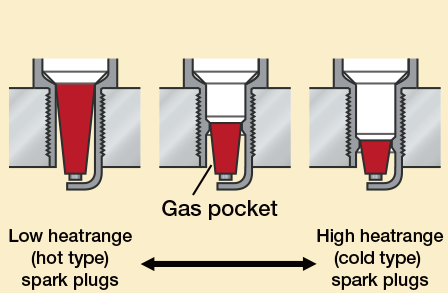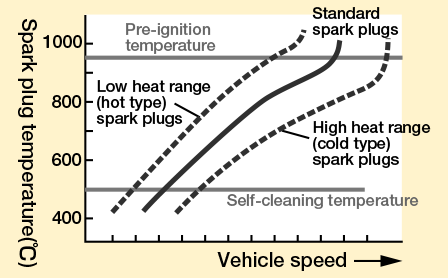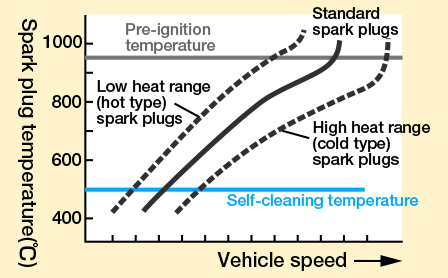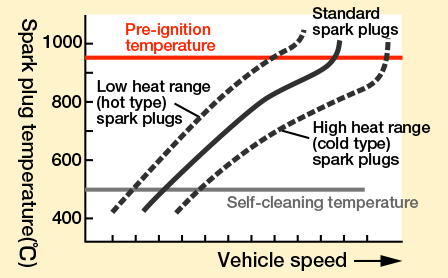Heat Range
Spark plug heat dispersal
The heat that the electrode section of the spark plug receives due to combustion is dispersed through the path in the figure.
The degree to which a spark plug disperses the heat it receives is called its “heat range”. Spark plugs with a high degree of heat dispersal are called high heat range (cold type) and those with a low degree of heat dispersal are called low heat range (hot type).
This is largely determined by the temperature of the gas inside the combustion chamber and the spark plug design.

Low heat range and high heat range
Low heat range plugs have long insulator leg sections and the surface area affected by the flame and the gas pocket capacity are large.
Also, since the heat release path from the insulator leg section to the housing is long, heat dispersal is low and the temperature of the center electrode rises easily.
On the other hand, high heat range plugs have short insulator legs and the surface area affected by the flame and the gas pocket capacity are small.
Also since the heat release path from the insulator leg section to the housing is short, heat dispersal is high and the temperature of the center electrode does not rise easily.

Spark plug temperature and vehicle speed (1)
The relationship between the spark plug temperature and vehicle speed and heat range is expressed with a graph like that in the figure. There are restrictions on the temperatures at which spark plugs can be used: the lower limit is the self-cleaning temperature and the upper limit is the pre-ignition temperature.A spark plug only functions completely when its center electrode temperature is between these temperatures of about 500°C and 950°C.

Spark plug temperature and vehicle speed (2) – self-cleaning temperature
When the center electrode temperature is 500°C or lower, free carbon generated when the fuel does not combust completely is deposited on the surface of the insulator. Therefore, the insulation between the insulator and the housing falls, electricity leaks occurs, the spark across the gap is incomplete, causes ignition failures.
This temperature of 500°C is called the self-cleaning temperature because above this temperature the carbon is naturally burnt away completely by combustion.

Spark plug temperature and vehicle speed (3) – pre-ignition temperature
When the center electrode reaches 950°C or higher, pre-ignition (early ignition) occurs, meaning that the electrode serves as a heat source and ignition occurs without a spark. Therefore, output falls and this can reach the level of electrode wear and insulator damage.

Spark plug temperature and vehicle speed (4)
Low heat range spark plugs have center electrode temperatures that rise easily and even at low-speed, they easily reach the self-cleaning temperature, so carbon is not deposited easily on the insulator section.
On the other hand, high heat range spark plugs have center electrode temperatures that do not rise easily, so they are unlikely to reach the pre-ignition temperature even at high speed.
Therefore, this type of spark plug is generally used for high speed, high output engines.
That is why it is necessary to select spark plugs with the appropriate heat range for the engine characteristics, running conditions, etc.

